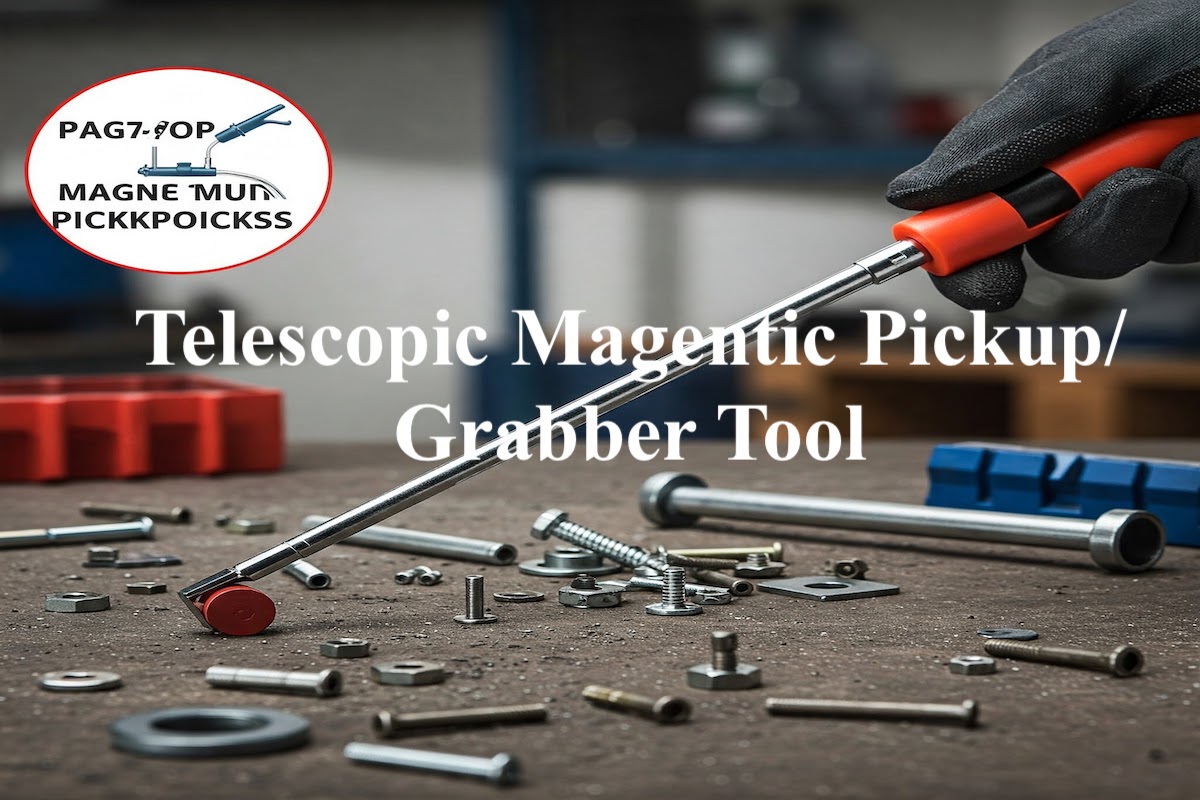The Best Features of Magnetic Telescopic Pickup Tools for Mechanics, DIYers, and Beyond
The Best Features of Magnetic Telescopic Pickup Tools for Mechanics, DIYers, and Beyond
An accidental drop into a tight, inaccessible space is an all-too-common frustration. Whether you're a professional mechanic navigating the labyrinthine depths of an engine bay, a dedicated DIY enthusiast tackling a home improvement project, or an industrial worker maintaining complex machinery, the interruption caused by a rogue metal part can be a significant time sink and a source of immense irritation. Enter the unsung hero of the toolbox: the magnetic telescopic pickup tool. This ingeniously simple yet remarkably effective device is a game-changer, and for a platform like Tendsupplies.com, which caters to a wide array of tool users, understanding its full potential is key.

This comprehensive guide will delve into the best features of magnetic telescopic pickup tools, exploring why they are indispensable for a multitude of tasks. We'll uncover their benefits, how to choose the right one, and answer some frequently asked questions, all while highlighting why this tool deserves a prominent place in every well-equipped toolkit.
The NoCry Telescoping Magnetic Pickup Tool.
Affiliate Disclosure
This article contains Amazon affiliate links. If you make a purchase through these links, Tend Industrial Supplies may earn a small commission at no additional cost to you. These commissions help us bring more hands-on product guides, reviews, and safety content to you.
More Than Just a Stick with a Magnet: The Core Features That Make a Difference
At its heart, a magnetic telescopic pickup tool combines the power of magnetism with the convenience of an extendable reach. But the best tools on the market offer a suite of features designed for optimal performance, durability, and user comfort.
-
The Power of the Magnet: Strength and Type
The primary function of the tool lies in its magnet. The lifting capacity, or pull strength, is a critical feature. This is often measured in pounds (lbs) or kilograms (kg) and indicates the maximum weight the magnet can securely hold.
- Neodymium Magnets (Rare Earth): These are the industry standard for high-quality pickup tools. Neodymium magnets (an alloy of neodymium, iron, and boron - NdFeB) are incredibly powerful for their size, offering a strong magnetic field capable of retrieving heavier items and providing a secure grip on smaller ones. Their strength ensures that once an object is captured, it stays put during retrieval. (Authority Link Idea: A link to a reputable magnet manufacturer or a scientific site explaining neodymium magnet properties, e.g., K&J Magnetics or a similar educational resource on magnetism.)
- Ferrite Magnets: While less powerful than neodymium, ferrite magnets are more corrosion-resistant and generally less expensive. They can be suitable for lighter-duty applications where extreme pull strength isn't the primary concern. However, for professional and serious DIY use, neodymium is typically preferred for its superior performance.
- Shielded Magnets/Powercaps: Some advanced models feature a "powercap" or shielded sides around the magnet. This design focuses the magnetic field at the tip, increasing direct pickup force and preventing the magnet from sticking to unwanted metal surfaces along the sides of the tool, which is especially useful in cluttered environments.
-
Telescopic Reach: Getting to the Unreachable
The "telescopic" aspect is what gives this tool its incredible versatility.
- Extendable Shafts: Quality tools offer a smooth, multi-section telescopic shaft, often made from durable materials like stainless steel or high-grade aluminum. This allows the user to extend the tool from a compact, pocket-friendly size to lengths that can reach deep into engine compartments, behind appliances, into narrow pipes, or down drains. Extension ranges can vary significantly, from a few inches to several feet.
- Locking Mechanisms: While not always present, some heavier-duty models might incorporate locking mechanisms to secure the shaft at a desired length, preventing accidental retraction or extension during use with heavier objects.
- Material and Durability: The shaft must withstand repeated extension and retraction without bending or breaking. Stainless steel offers excellent strength and corrosion resistance, making it a popular choice.
-
Ergonomic Handle Design: Comfort and Control
Related article: The Indispensable NoCry Telescoping Magnetic Pickup Tool (Up to 20% Off Now!)
A tool that's used frequently, sometimes in awkward positions, needs to be comfortable and easy to control.
- Cushioned Grips: Many magnetic pickup tools feature cushioned, non-slip rubber or vinyl grips. This is crucial for maintaining a firm hold, especially when hands are oily, greasy, or wet – common conditions in automotive and industrial settings.
- Handle Shape and Size: A well-designed handle fits comfortably in the hand, reducing fatigue during prolonged use. Some are pen-shaped for precision, while others might have a more substantial grip for heavier tasks.
-
Head Design: Versatility in Application
The "business end" of the tool can also vary.
- Fixed vs. Flexible/Pivoting Heads: While many tools have a fixed magnet at the end, some premium versions offer a flexible or pivoting head. This allows the magnet to be angled, enabling it to reach around corners or access objects that are not in a direct line of sight. This feature dramatically enhances the tool's problem-solving capabilities.
- Integrated LED Lights: This is an increasingly popular and incredibly useful feature. A small, bright LED light integrated near the magnetic tip illuminates dark and confined spaces, making it much easier to locate the dropped item. This is invaluable when working under vehicles, inside machinery, or in poorly lit areas. (Authority Link Idea: A link to a blog post or article discussing the importance of good lighting in workshops or for detailed mechanical work).
-
Compact and Portable: Always Within Reach
- Pocket Clips: Many smaller, pen-sized magnetic pickup tools come with a pocket clip, similar to that of a pen. This allows mechanics and technicians to keep the tool readily accessible in a shirt or pants pocket, ensuring it's always there when needed.
- Lightweight Construction: The use of materials like aluminum and the compact nature of neodymium magnets mean that even powerful tools can be surprisingly lightweight and easy to carry.
The Indispensable Assistant: Benefits Across Various Applications
The true value of a magnetic telescopic pickup tool is realized in its wide range of applications and the tangible benefits it offers.
For Mechanics (Automotive, Aviation, Marine):
- Retrieving Dropped Hardware: This is the most obvious benefit. Nuts, bolts, screws, washers, sockets, and even small tools dropped into engine bays, under dashboards, or into other tight crevices can be quickly and easily retrieved, saving significant time and frustration. Imagine the alternative: often, it involves partially disassembling components to gain access.
- Preventing Foreign Object Debris (FOD): In critical applications like aviation or engine rebuilding, ensuring no stray metal parts are left behind is paramount. A magnetic pickup tool is essential for sweeping areas and confirming no metallic FOD is present.
- Enhanced Safety: Reaching into hot or sharp areas with your hands can lead to burns or cuts. A pickup tool provides a safe distance.
- Improved Efficiency: Less time spent searching for dropped items means more time spent on the actual repair or maintenance task, directly improving workflow and productivity. For a professional, time is money, and this tool is a proven time-saver.
For DIY Enthusiasts and Home Improvement:
- Simplified Repairs: Dropped a screw while fixing an appliance? Lost a nail behind a workbench? A magnetic pickup tool makes these minor annoyances trivial.
- Computer and Electronics Repair: Retrieving tiny screws from inside computer cases or electronic devices without causing damage is made easier.
- Plumbing Tasks: Retrieving lost metal items from drains (before they go too far!).
- Workshop Organization: Quickly picking up spilled tacks, nails, or other small ferrous items from the floor or workbench.
- Crafting and Hobbies: Useful for picking up small metal craft supplies, needles, or pins.
For Industrial and Manufacturing Settings:
- Machine Maintenance: Retrieving dropped components from within complex machinery, reducing downtime.
- Assembly Lines: Assisting in the placement or retrieval of small metal parts during assembly processes.
- Quality Control: Ensuring no stray metal filings or components are present in finished products.
- Safety Sweeps: Clearing work areas of sharp metallic debris that could cause injury or damage equipment.
General Benefits for All Users:
- Reduced Frustration: The sheer relief of quickly retrieving an item you thought was lost or would require significant effort to reach is immeasurable.
- Cost-Effective: These tools are generally inexpensive, especially considering the time and potential damage they can save. An investment in a good quality magnetic pickup tool pays for itself many times over.
- Versatility: Beyond just picking up dropped items, they can be used for holding nuts or screws in place while starting a thread in an awkward spot, or even for gently positioning small metal components.
Choosing Your Magnetic Ally: What to Look For
When selecting a magnetic telescopic pickup tool for Tendsupplies.com customers, consider these factors:
- Pull Strength: Match the magnet's lifting capacity to the typical items you'll be retrieving. For general mechanics and DIY, a tool with a 5-15 lb pull strength is often very versatile. Stronger magnets (20 lbs+) are available for heavier-duty industrial tasks.
- Extended Length: How far do you need to reach? Consider the types of spaces you typically work in. A longer extension offers more versatility but might be bulkier.
- Collapsed Length and Portability: If you need to carry it in a pocket, a smaller collapsed size with a pocket clip is ideal.
- Magnet Type: Prioritize Neodymium magnets for superior strength and reliability.
- Build Quality: Look for sturdy shaft construction (stainless steel is excellent) and a comfortable, durable handle. Check reviews for comments on longevity.
- Special Features:
- LED Light: Highly recommended for anyone working in less-than-ideal lighting.
- Flexible/Pivoting Head: A significant advantage for reaching around obstacles.
- Powercap/Shielded Magnet: Useful for targeted pickups in cluttered areas.
- Brand Reputation and Reviews: Look for tools from reputable manufacturers known for quality. Customer reviews can offer valuable insights into real-world performance and durability. (Authority Link Idea: A link to a trusted tool review website or a popular mechanic/DIY forum discussing favorite hand tools, e.g., a relevant thread on Garage Journal or a review from a site like Pro Tool Reviews, if applicable and unbiased).
Tendsupplies.com: Equipping You for Success
For customers of Tendsupplies.com, a magnetic telescopic pickup tool isn't just another gadget; it's a problem-solver that aligns perfectly with the need for efficient and effective tools in both home improvement and industrial settings. Whether you're Browse for "Hand tools" or "Home improvement tools," adding a quality magnetic retriever to your cart is a smart move.
Key Takeaways: The Magnetic Advantage
- Saves Time and Reduces Frustration: Instantly retrieve dropped metal objects from hard-to-reach places.
- Enhances Safety: Avoid cuts and burns by keeping hands out of hazardous areas.
- Versatile Applications: Essential for mechanics, DIYers, industrial workers, and hobbyists.
- Key Features to Prioritize: Strong Neodymium magnet, sufficient telescopic reach, ergonomic handle, and consider models with LED lights or flexible heads for added utility.
- Cost-Effective Investment: A small price for a tool that provides immense value and convenience.
Frequently Asked Questions (FAQs)
Q1: How much weight can a magnetic pickup tool actually lift? A: This varies significantly based on the tool's magnet strength. Smaller, pen-style tools might lift 1-5 lbs, while heavy-duty versions can lift 15-30 lbs or even more. The stated pull strength is usually tested under ideal conditions (flat, clean steel surface). The actual lifting capacity for an oddly shaped or coated item might be slightly less. Always check the manufacturer's specifications.
Q2: Will a magnetic pickup tool damage sensitive electronics? A: Powerful neodymium magnets can potentially damage certain sensitive electronics or magnetic storage media (like old floppy disks or credit card strips if held extremely close for a prolonged period). However, for most modern electronics like smartphones or the internal components of a typical car, incidental contact while retrieving a screw is unlikely to cause harm. It's always prudent to be cautious and avoid prolonged direct contact with highly sensitive devices. Most magnetic pickup tools are designed for retrieving passive metal components rather than interacting directly with delicate electronic circuits.
Q3: Can I use a magnetic pickup tool to find studs in a wall? A: Yes, a strong magnetic pickup tool can often help locate metal drywall screws or nails used to attach drywall to wooden or metal studs. By slowly sweeping the tool across the wall, you'll feel the magnet attract to these fasteners, indicating the stud locations. While dedicated electronic stud finders are more precise, a magnetic pickup tool can be a handy alternative.
Q4: How do I clean the magnet if it gets covered in metal shavings? A: Simply wipe the metal shavings off with a gloved hand or a shop towel. For very fine metallic dust, a piece of tape can be used to dab the particles off the magnet. Some tools with "powercaps" or release mechanisms make this even easier by shielding the magnet until you're ready to retrieve an item or by providing a way to mechanically release the attracted debris.
Q5: Are there magnetic pickup tools that don't use permanent magnets? A: While the vast majority of handheld pickup tools use permanent magnets (like Neodymium or Ferrite) due to their convenience and continuous magnetic field without needing power, there are industrial "electromagnetic" lifters. These require an electric current to activate the magnet and are typically used for very heavy lifting applications, not for the handheld retrieval tasks discussed here. For the purposes of mechanics and DIY projects, permanent magnet tools are the standard. (Authority Link Idea: An educational page explaining the difference between permanent magnets and electromagnets, perhaps from a university physics department or a science education website).
Conclusion: Don't Get Stuck – Get Magnetic!
The magnetic telescopic pickup tool is a testament to how a simple concept, executed well, can provide enormous utility. For the professional mechanic striving for efficiency, the DIYer aiming for a frustration-free project, or the industrial worker focused on safety and productivity, this tool is an invaluable asset. Its ability to transform a potentially time-consuming and annoying problem into a quick and easy fix makes it more than just a convenience – it's a necessity.
When Browse the extensive range of tools at Tendsupplies.com, remember the humble yet mighty magnetic telescopic pickup tool. It’s a small investment that delivers big returns in time saved, frustration avoided, and projects completed more smoothly. Get yours today and experience the magnetic advantage!










